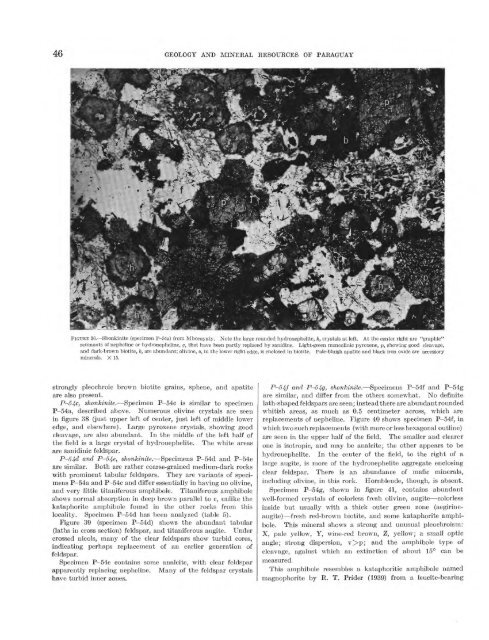Geology and Mineral Resources of Paraguay A Reconnaissance
Geology and Mineral Resources of Paraguay A Reconnaissance
Geology and Mineral Resources of Paraguay A Reconnaissance
- No tags were found...
You also want an ePaper? Increase the reach of your titles
YUMPU automatically turns print PDFs into web optimized ePapers that Google loves.
46 GEOLOGY AND MINERAL RESOURCES OF PARAGUAYFIGURE 36. Shonkinite (specimen P-54a) from Mbocayaty. Note the large rounded hydronephelite, h, crystals at left. At the center right are "graphic"remnants <strong>of</strong> nepheline or hydronepheline, g, that have been partly replaced by sanidine. Light-green monoelinic pyroxene, p, showing good cleavage,<strong>and</strong> dark-brown biotite, b, are abundant; olivine, o, in the lower right edge, is enclosed in biotite. Pale-bluish apatite <strong>and</strong> black iron oxide are accessoryminerals. X 15.strongly pleochroic brown biotite grains, sphene, <strong>and</strong> apatiteare also present.P 54c, shonkinite. Specimen P 54c is similar to specimenP-54a, described above. Numerous olivine crystals are seenin figure 38 (just upper left <strong>of</strong> center, just left <strong>of</strong> middle loweredge, <strong>and</strong> elsewhere). Large pyroxene crystals, showing goodcleavage, are also abundant. In the middle <strong>of</strong> the left half <strong>of</strong>the field is a large crystal <strong>of</strong> hydronephelite. The white areasare sanidinic feldspar.P-54d <strong>and</strong> P-S4e, shonkinite. Specimens P-54d <strong>and</strong> P-54eare similar. Both are rather coarse-grained medium-dark rockswith prominent tabular feldspars. They are variants <strong>of</strong> specimensP-54a <strong>and</strong> P-54c <strong>and</strong> differ essentially in having no olivine,<strong>and</strong> very little titaniferous amphibole. Titaniferous amphiboleshows normal absorption in deep brown parallel to c, unlike thekataphorite amphibole found in the other rocks from thislocality. Specimen P-54d has been analyzed (table 5).Figure 39 (specimen P-54d) shows the abundant tabular(laths in cross section) feldspar, <strong>and</strong> titaniferous augite. Undercrossed nicols, many <strong>of</strong> the clear feldspars show turbid cores,indicating perhaps replacement <strong>of</strong> an earlier generation <strong>of</strong>feldspar.Specimen P-54e contains some analcite, with clear feldsparapparently replacing nepheline. Many <strong>of</strong> the feldspar crystalshave turbid inner zones.P-64f <strong>and</strong> P-S4g, shonkinite. Specimens P-54f <strong>and</strong> P-54gare similar, <strong>and</strong> differ from the others somewhat. No definitelath-shaped feldspars are seen; instead there are abundant roundedwhitish areas, as much as 0.5 centimeter across, which arereplacements <strong>of</strong> nepheline. Figure 40 shows specimen P-54f, inwhich two such replacements (with more or less hexagonal outline)are seen in the upper half <strong>of</strong> the field. The smaller <strong>and</strong> clearerone is isotropic, <strong>and</strong> may be analcite; the other appears to behydrouephelite. In the center <strong>of</strong> the field, to the right <strong>of</strong> alarge augite, is more <strong>of</strong> the hydronephelite aggregate enclosingclear feldspar. There is an abundance <strong>of</strong> mafic minerals,including olivine, in this rock. Hornblende, though, is absent.Specimen P 54g, shown in figure 41, contains abundantwell-formed crystals <strong>of</strong> colorless fresh olivine, augite colorlessinside but usually with a thick outer green zone (aegirineaugite)fresh red-brown biotite, <strong>and</strong> some kataphorite amphibole. This mineral shows a strong <strong>and</strong> unusual pleochroism:X, pale yellow, Y, wine-red brown, Z, yellow; a small opticangle; strong dispersion, v>p; <strong>and</strong> the amphibole type <strong>of</strong>cleavage, against which an extinction <strong>of</strong> about 15° can bemeasured.This amphibole resembles a kataphoritic amphibole namedmagnophorite by R. T. Prider (1939) from a leucite-bearing
















